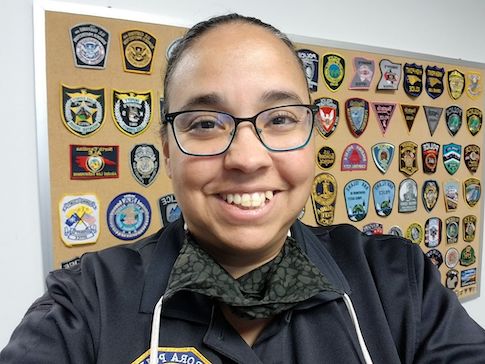No, Transient Evidence is Not Evidence Left Behind by Homeless Criminals
Research is the name of the game if a crime writer’s goal is accuracy about a particular aspect of their story, such as murder, cops, and investigations of crimes. Unfortunately, some writers avoid any and all cop-type research, believing they already have all the answers because they watch crime shows on television, and/or their BFF’s cousin’s next door neighbor once lived in the same town as a guy who used to work with a woman who dated the brother of a man who once stood in a grocery store checkout line next to a police detective’s auto mechanic. Well, that sort of connection won’t quite cut it if the desired result is realism.
So, to assist writers who may have incorrectly used one or more of the terms listed below, well, here you go. Yes, I’ve seen each of these used incorrectly. For example, no, transient evidence is not the evidence left behind by homeless criminals …
ABFO Scales: (American Board of Forensic Odontology scales). An L-shaped piece of plastic used in crime scene photography. Scales are marked with circles, black and white bars, and gray bars. These markings aid in distortion compensation and provide exposure determination. Measurements on the scales are typically marked in millimeters.
Bindle Paper: Paper that’s folded to safely contain, store, and transport trace evidence.
Crime Writer: Person who commits multiple murders within the narrow confines of book covers. Crime writers are known to leave behind scores of evidence and sometimes a handful of cliches.
Faraday Bag: Special collection bags for electronic parts. Faraday bags are lined to protect the contents from electromagnetic forces that could damage or destroy evidence.
Historical Fiction: The official residence of cordite. Actually, historical fiction is the ONLY place where cordite and its odor should be used by writers.
Latent Print: A print that’s not readily visible, or one that’s visible only by enhancement.
Odor of Cordite: An imaginary odor detected only by modern writers who should know better … but don’t.
Porous Container: Packaging through which liquids or vapors may pass (cloth, paper, etc.).
Presumptive Test: A non-confirmatory test used to screen for the presence of substances such as drugs or blood. Test kits used by officers in the field are presumptive test kits. Confirmation testing is conducted in official laboratories by trained and/or certified professionals.
Primary Crime Scene: In homicide investigations, the place where the body is found is the primary crime scene. Typically, this is where the investigation begins. Keep in mind, though, there may be multiple crime scenes (crime scene – any place where evidence of a crime is found).
Scene of the Crime: The location where a crime was committed.
Slide-Racking: The totally unbelievable action of pulling and releasing the slide on a semi-automatic pistol just prior to engaging a dangerous situation. Cops carry guns with a round in the chamber. To rack the slide would eject the pre-loaded round leaving them with one less bullet.
Tertiary DNA: DNA can be accidentally transferred from one object to another. A good example could be the killer who shares an apartment with an unsuspecting friend. He returns home after murdering someone and then tosses his blood-spatter-covered shirt into the washer along with his roommate’s clothing. The machine churns and spins through its wash cycles, an action that spreads the victim’s DNA throughout the load. Police later serve a search warrant on the home, seize the clothing, and discover the victim’s DNA on the roommate’s jeans. The innocent roommate is arrested for murder.

Tertiary Transfer of DNA Evidence
The same can occur with touch DNA. A man shares a towel with his wife and his DNA is subsequently transferred to her face and neck. Later, a stranger wearing gloves chokes the woman to death, transferring the husband’s DNA from the victim’s face to the killer’s gloves. The assailant removes the gloves and leaves them at the scene. Police confiscate the gloves, test them, and find the husband’s DNA. He is then charged for his wife’s death while the real killer is free to murder again.
The example above (the choking case) actually happened, and those of you who attended the Writers’ Police Academy session taught by DNA expert Dr. Dan Krane heard him speak of it. He was the expert who proved this was indeed possible and he testified to it in the groundbreaking case involving accused killer Dr. Dirk Grenadier.
Transient Evidence: Evidence which could lose could lose its evidentiary value if not preserved and protected from the elements or other hazards (blood, semen, etc.). This is not evidence left behind by homeless people. It could be, though, if the killer just happened to be someone who lives on the streets. If so, the items collected could then be called transient transient evidence.
White Horse Syndrome: No, FBI special agents do not ride into town on white horses to take over cases from local cops, nor do they work local murder cases. And … they do not investigate all kidnapping cases. Many writers, bless their hearts, are infected with White Horse Syndrome (WHS). Fortunately, it’s an easily curable disease. Unfortunately, though, some refuse to seek help.
If you or someone you know is affected by WHS, immediate intervention is needed.
To help battle WHS I strongly urge you to attend the upcoming Writers’ Police Academy Online daylong seminar “Mystery and Murder: Transforming Reality into Fantastic Fiction.” In this session you’ll learn behind the scenes tips, tactics, and techniques used by top crime scene investigators Lisa Provost and Lisa Black. Also, forensic psychology expert Dr. Katherine Ramsland is scheduled to teach a fascinating workshop about staged homicide scenes.
Then, in a rare learning opportunity, #1 bestselling author Tami Hoag wraps up the event with her class “Not Just the Facts, Ma’am.” Hoag’s amazing workshop details how to carefully weave all your newfound knowledge of police and forensic work into your story.
Attending Writers’ Police Academy Online classes could be the important first step on the road to recovery from the dreaded White Horse Syndrome.
Registration details and an all new website are coming soon.
In addition to Tami Hoag’s session, other classes include:
“Little Known Facts About Crime Scenes” – instructor Lisa Black.
 Lisa Black is the NYT bestselling author of 14 suspense novels, including works that have been translated into six languages, optioned for film, and shortlisted for the inaugural Sue Grafton Memorial Award. She is also a certified Crime Scene Analyst and certified Latent Print Examiner.
Lisa Black is the NYT bestselling author of 14 suspense novels, including works that have been translated into six languages, optioned for film, and shortlisted for the inaugural Sue Grafton Memorial Award. She is also a certified Crime Scene Analyst and certified Latent Print Examiner.
“Sleuthing the Clues in Staged Homicides” – instructor Dr. Katherine Ramsland.
 Katherine Ramsland teaches forensic psychology at DeSales University, where she is the Assistant Provost. She has appeared on more than 200 crime documentaries and magazine shows, is an executive producer of Murder House Flip, and has consulted for CSI, Bones, and The Alienist. The author of more than 1,000 articles and 68 books, including How to Catch a Killer, The Psychology of Death Investigations, and The Mind of a Murderer, she spent five years working with Dennis Rader on his autobiography, Confession of a Serial Killer: The Untold Story of Dennis Rader, The BTK Killer. Dr. Ramsland currently pens the “Shadow-boxing” blog at Psychology Today and teaches seminars to law enforcement.
Katherine Ramsland teaches forensic psychology at DeSales University, where she is the Assistant Provost. She has appeared on more than 200 crime documentaries and magazine shows, is an executive producer of Murder House Flip, and has consulted for CSI, Bones, and The Alienist. The author of more than 1,000 articles and 68 books, including How to Catch a Killer, The Psychology of Death Investigations, and The Mind of a Murderer, she spent five years working with Dennis Rader on his autobiography, Confession of a Serial Killer: The Untold Story of Dennis Rader, The BTK Killer. Dr. Ramsland currently pens the “Shadow-boxing” blog at Psychology Today and teaches seminars to law enforcement.
“The Call You Get is Not Always the Call You Get: When a Routine Death Investigation Crosses State Lines and Multiple Jurisdictions” – instructor Lisa Provost, Forensic Supervisor at Aurora Colorado Police Department.
 Lisa has completed over five-hundred-hours of forensic training that includes basic death investigation, child death investigation, advanced child death investigation, and officer-involved shooting investigations.
Lisa has completed over five-hundred-hours of forensic training that includes basic death investigation, child death investigation, advanced child death investigation, and officer-involved shooting investigations.
 Tami Hoag is the #1 International bestselling author of more than thirty books published in more than thirty languages worldwide, with more than forty million books in print. Renown for combining thrilling plots with character-driven suspense, crackling dialogue and well-research police procedure, Hoag first hit the New York Times bestseller list in 1996 with NIGHT SINS, and each of her books since has been a bestseller, including her latest, THE BOY. She lives in the greater Los Angeles area.
Tami Hoag is the #1 International bestselling author of more than thirty books published in more than thirty languages worldwide, with more than forty million books in print. Renown for combining thrilling plots with character-driven suspense, crackling dialogue and well-research police procedure, Hoag first hit the New York Times bestseller list in 1996 with NIGHT SINS, and each of her books since has been a bestseller, including her latest, THE BOY. She lives in the greater Los Angeles area.
Here’s a brief video of crime scene processing, photography, and evidence collection.













Great list of “definitions” Lee 🙂